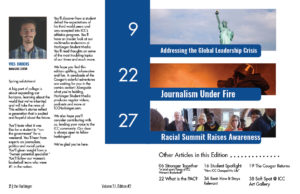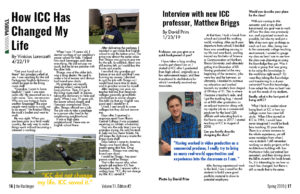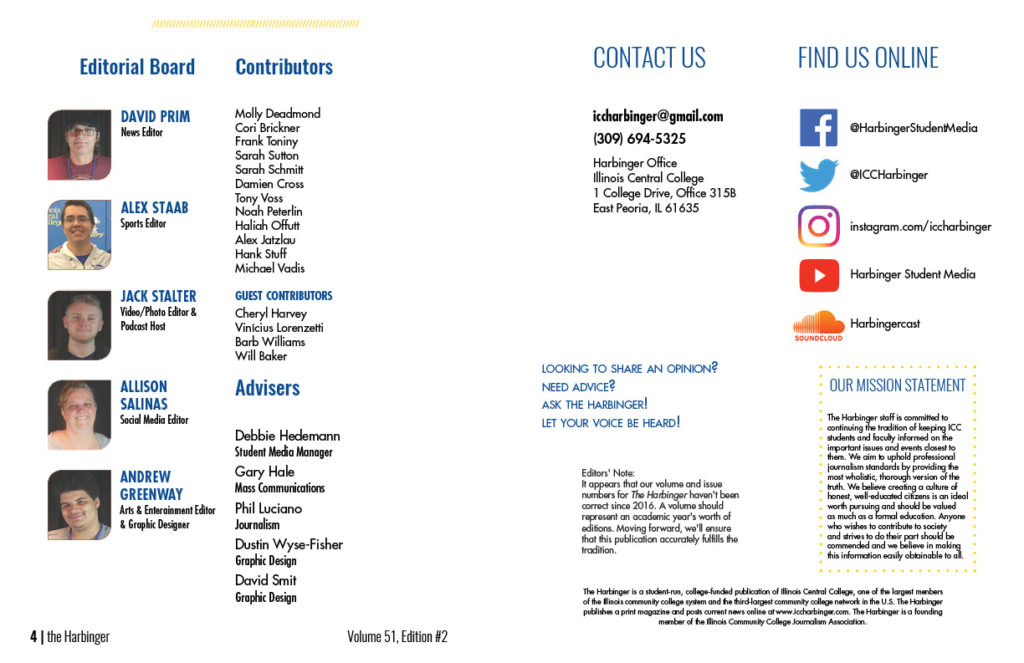For the People, By Design: the Student Behind the Print Edition
By Andrew Greenway, 4/26/19


Page 16 & 17, featuring student and staff profile from editor David Prim and the personal story of Vinicius Lorenzetti 
Contact Us page
50+ hours, 21 articles, 1 student with a goal.
This is no exaggeration, I worked full-time for over the past two weeks designing a magazine for Illinois Central College and it was one of the most tedious, stressful, nerve-wracking, and tiresome projects I’ve had to work on in both my time studying graphic design and working for the Harbinger.
In fact, I stayed home one day from my graphic design class just to continue to work on it. At first, I looked back on the experience with a lot of regrets. I couldn’t describe how ironic it felt to give up attending graphic design class to stay home, sit at my desk for 12 hours and eat nothing all day for the sake of completing a design project. But, I would definitely say that my process was an extremist version of design; it wasn’t that of a normal designer or even that of your average journalist.
Typically graphic designers work in teams, each contributing their own unique perspectives, talents, and sets of skills to the mutual ambition. No matter the form or medium the goal remains the same, we assess a problem and solve it using by using visuals to create a solution. The process is not a complex one nor is it difficult to learn. The greatest challenges for us as designers isn’t finding a solution.
Our greatest challenge is that there are only 24 hours in a day.
Unfortunately, as artists, we don’t always have the luxury of time and, sometimes teammates, we’ll need to rise to the challenges set before us. If we miss a deadline, we bear the burden of responsibility. If we make an error that costs us money, we are the only ones to blame. The stress of our job comes from the reality that you are your team’s greatest asset and the great liability if things go wrong.
However, I don’t see myself as unfortunate to find myself under these circumstances.
It’s a challenge. Sometimes challenges are uncomfortable experiences. Sometimes they’re stressful. Meanwhile, others are there to test your resolve on your path to achieve great things. We, designers, aren’t a bullish bunch and, in every project, we have to step away from what we know to see the full picture.
But, in some ways, I can hardly be called a designer. More often that not, I find myself getting lost in the research side of my work. Investigating the styles of the past, trying to decipher every color decision made by Muller Brockmann or every glyph placement in a Paula Scher poster, or even just figuring out what it means to be a designer and what responsibilities I’ll be forced to carry in my work and these answers may never be so cut and dry. So, my inner journalist comes out.
As designers, we go into every project with a process in mind: we gather information, generate ideas, produce mock-ups and prototypes, receive feedback, and we reiterate until we find the best solution. As journalists, often times our approach is less goal-oriented and more focused on the interpretative nature of the situation. We have to scrutinize the events and consider many different perspectives when we present our work, it requires us to keep a different set of values in mind than designers.
We search for the stories most relevant to our audience, ask questions, verify our sources, do the legwork and search for every piece of information we can. Then, we have the difficult task of thinking before we speak. Carefully choosing our words, what phrases to include and exclude. Does a phrase imply impartiality? Bias towards a party? Does this verbiage restrict our audience, who will understand? We are forced to plan our thoughts out, often to the smallest word, to bring the most holistic, understandable depiction of the truth; all in a two-hour deadline.
So you see, even though the values change, the goals remain the same. From designers to journalists to artists and poets and politicians, teachers, mechanics, and athletes, we all have the difficult task of communicating complex ideas in a very limited timeframe.
In total, I’ve sent hundreds of emails, made various phone calls, dozens of sketches, several different version of the same magazine you’ll hold in your hands at the end of the semester.
I have no doubt in my mind that something went wrong in the process. Whether it be a misspelling, poor quality photo, or an awkward spacing, I know that my work isn’t done. It’ll never be perfect nor will I ever find satisfaction so long as there are areas to scrutinize.
But, I believe that is the hallmark of great designer, let alone a good person, to accept their faults and learn from their mistakes.
Throughout life, we’ll have to be open to new ideas and willing to have a flexible vision if we hope to succeed. This is not a condemnation of perfectionism nor is it an advertisement for laziness. I believe that no matter your profession you have a responsibility to your audience to be an honest and effective communicator. Sometimes this is easier done alone but I typically find my efforts are better received when I open myself up to collaborate with others which is something I’ve learned throughout the process of designing this semester’s Harbinger Print Edition.
As journalists, we have the responsibility to our audience to present information factually and, as designers, have the responsibility to our audience to present information, effectively and visually.
And although it came at a sacrifice to myself, I feel that the process has given me a valuable bit of insight into the stresses of people counting on you and I hope that our efforts show.

